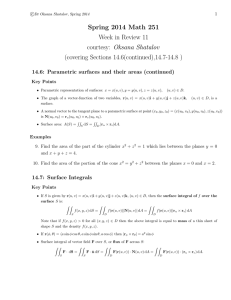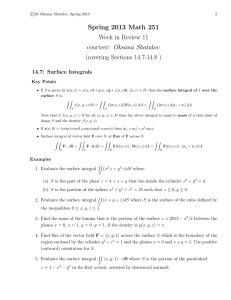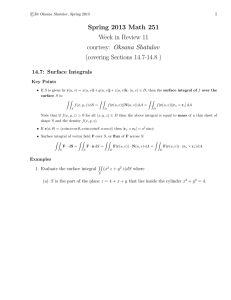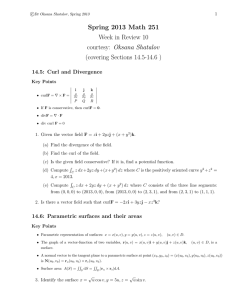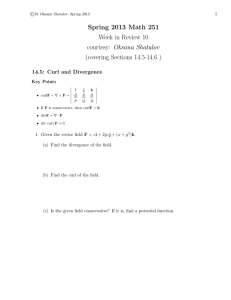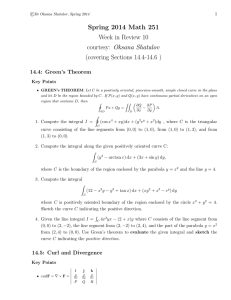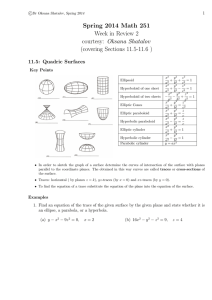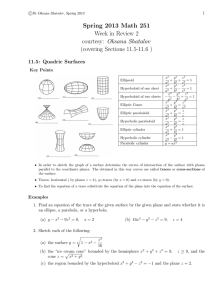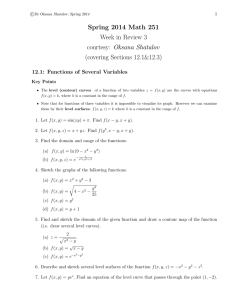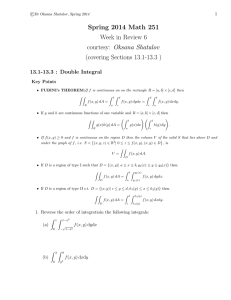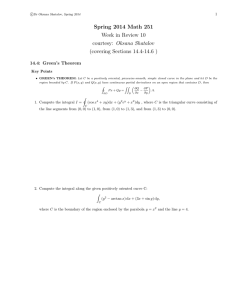Document 10496181
advertisement
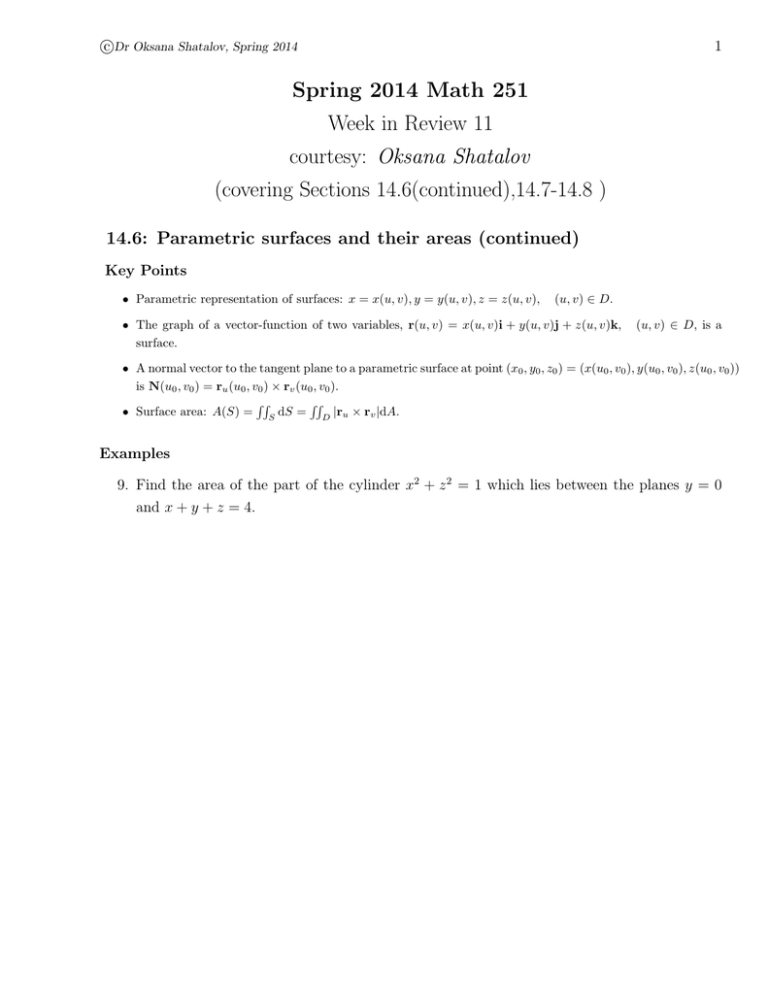
c Dr Oksana Shatalov, Spring 2014 1 Spring 2014 Math 251 Week in Review 11 courtesy: Oksana Shatalov (covering Sections 14.6(continued),14.7-14.8 ) 14.6: Parametric surfaces and their areas (continued) Key Points • Parametric representation of surfaces: x = x(u, v), y = y(u, v), z = z(u, v), (u, v) ∈ D. • The graph of a vector-function of two variables, r(u, v) = x(u, v)i + y(u, v)j + z(u, v)k, surface. (u, v) ∈ D, is a • A normal vector to the tangent plane to a parametric surface at point (x0 , y0 , z0 ) = (x(u0 , v0 ), y(u0 , v0 ), z(u0 , v0 )) is N(u0 , v0 ) = ru (u0 , v0 ) × rv (u0 , v0 ). RR RR • Surface area: A(S) = S dS = D |ru × rv |dA. Examples 9. Find the area of the part of the cylinder x2 + z 2 = 1 which lies between the planes y = 0 and x + y + z = 4. c Dr Oksana Shatalov, Spring 2014 2 10. Find the area of the portion of the cone x2 = y 2 + z 2 between the planes x = 0 and x = 2. 14.7: Surface Integrals Key Points • If S is given by r(u, v) = x(u, v)i + y(u, v)j + z(u, v)k, (u, v) ∈ D, then the surface integral of f over the surface S is: ZZ ZZ ZZ f (x, y, z) dS = f (r(u, v))|N(u, v)| dA = f (r(u, v))|ru × rv | dA S D D Note that if f (x, y, z) > 0 for all (x, y, z) ∈ D then the above integral is equal to mass of a thin sheet of shape S and the density f (x, y, z). • If r(φ, θ) = ha sin φ cos θ, a sin φ sin θ, a cos φi then |rφ × rθ | = a2 sin φ • Surface integral of vector field F over S, or flux of F across S: ZZ ZZ ZZ ZZ F · dS = F · n̂ dS = F(r(u, v)) · N(u, v) dA = F(r(u, v)) · (ru × rv ) dA. S S D D Examples 1. Evaluate the surface integral RR (x2 z + y 2 z)dS where S (a) S is the part of the plane z = 4 + x + y that lies inside the cylinder x2 + y 2 = 4. c Dr Oksana Shatalov, Spring 2014 3 (b) S is the portion of the sphere x2 + y 2 + z 2 = 25 such that z ≤ 0, y ≥ 0. 2. Evaluate the surface integral RR S the inequalities 0 ≤ x, y, z ≤ 1. (x + y + z)dS where S is the surface of the cube defined by c Dr Oksana Shatalov, Spring 2014 4 3. Find the mass of the lamina that is the portion of the surface z = 2013 − x2 /2 between the planes x = 0, x = 1, y = 0, y = 1, if the density is ρ(x, y, z) = x. 4. Find flux of the vector field F = hx, y, 1i across the surface S which is the boundary of the region enclosed by the cylinder y 2 + z 2 = 1 and the planes x = 0 and x + y = 5. Use positive (outward) orientation for S. c Dr Oksana Shatalov, Spring 2014 5. Evaluate the surface integral 5 RR hx, y, 1i · dS where S is the portion of the paraboloid S z = 1 − x2 − y 2 in the first octant, oriented by downward normals. 14.8: Stokes’ Theorem Key Points • Let S be an oriented piece-wise-smooth surface that is bounded by a simple, closed, piecewise smooth boundary curve C with positive orientation. Let F be a vector field whose components have continuous partial derivatives on an open region in R3 that contains S. Then I ZZ F · dr = curlF · dS. C S Examples H 6. Use Stokes’ Theorem to evaluate C F~ · d~r, where F~ (x, y, z) =< 3z, 5x, −2y > and C is the ellipse in which the plane z = y + 3 intersects the cylinder x2 + y 2 = 4, with positive orientation as viewed from above. c Dr Oksana Shatalov, Spring 2014 6 7. Find the work performed by the forced field F = h−3y 2 , 4z, 6xi on a particle that traverses the triangle C in the plane z = 21 y with vertices A(2, 0, 0), B(0, 2, 1), and O(0, 0, 0) with a counterclockwise orientation looking down the positive z-axis. I 8. Evaluate I = C F · dr if F = h2y + 3ex , z − y 8 , x + ln(z 2 + 1)i and C is the curve of inter- section of the plane x+y+z = 0 and sphere x2 +y 2 +z 2 = 1. (Orient C to be counterclockwise when viewed from above). c Dr Oksana Shatalov, Spring 2014 7 9. Verify Stokes’ Theorem for the surface S: x2 + y 2 + 5z = 1, z ≥ −5 (oriented by upward normal) and the vector field F~ = xz~i + yz~j + (x2 + y 2 )~k.

